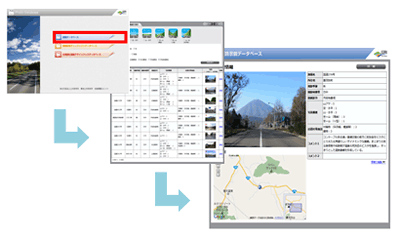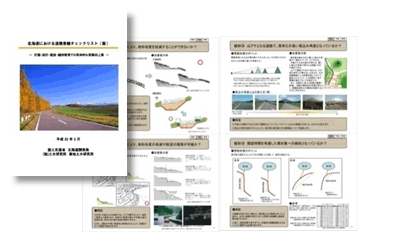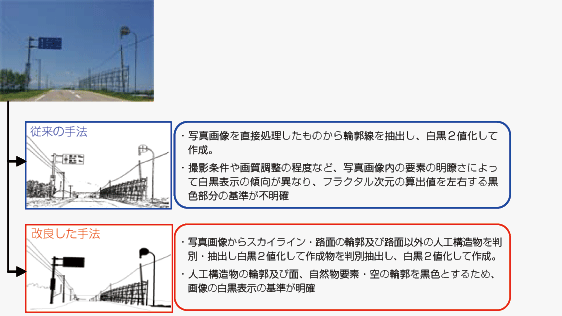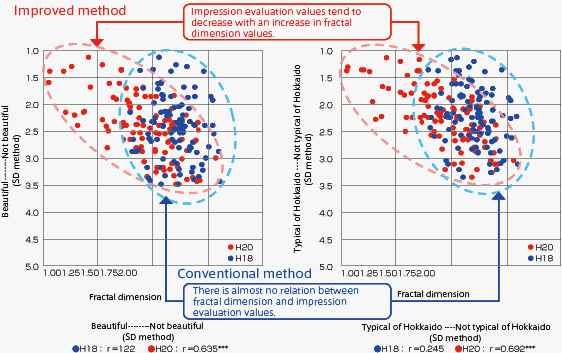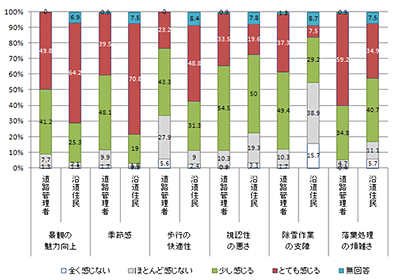|
Top > Research Theme > Strategic Study A Study on the Creation of Beautiful and Pleasant Roadside Environments in Hokkaido
Tourism is a key industry in Hokkaido. Many domestic and overseas tourists visit the island for its beautiful landscape and other features. In particular, the number of self-drive tourists from overseas is increasing rapidly. Social needs for improvements in roadside landscapes are also increasing with the full-scale implementation of the Scenic Byway Hokkaido scheme. Therefore, this study focuses on the landscapes (internal landscapes) of roads that serve as main transport routes and important viewpoints, and presents road scenery evaluation methods and improvement measures, as well as highway landscaping methods that can contribute to landscape and environmental improvement. We aim to contribute to the improvement of roadside landscapes in cold, snowy areas through these studies.
Landscape improvement measures There are many suburbs in Hokkaido where natural and rural landscapes of world-class beauty can be enjoyed while driving on roads. However, snow-protection and various other roadside facilities also exist to ensure safe and smooth traffic and maintenance/management of roads, blocking the view of beautiful landscapes that extend behind them. Against such a background, this study presents specific landscape improvement measures that can lead to cost reductions, easier maintenance/management and landscape conservation, for the purpose of effective improvement in road landscapes in cold, snowy regions. Such measures include “landscape creation by subtracting,” which aims to reduce facilities while maintaining necessary road functions. These achievements have been used as the basis for development of the Road Landscape Database and Road Landscape Checklist in Hokkaido (draft).
Roadside facilities that block Hokkaido’s beautiful background landscapes (right)
Road Landscape Database
Road Landscape Checklist in Hokkaido (draft))
Landscape evaluation With the recent increase in landscape improvement efforts in public works projects, road landscape evaluation is becoming increasingly necessary, and the necessity of consensus building based on discussions with relevant parties is also increasing. However, since no road landscape evaluation methods have been established and there are no unified guidelines or standards, difficulties are encountered in landscape examination and consensus building. If a road landscape evaluation method can be used as a guideline that reflects subjective personal feelings to a certain degree, it can be an effective tool to facilitate landscape examination and consensus building. Therefore, this study aims to present a road landscape evaluation method that can be applied as a tool for landscape examination and consensus building.
An example of a road landscape evaluation method (combination of personal impression and quantitative evaluation) Applicability was improved by reflecting the impression evaluation by the SD method and improving the image recognition method in fractal analysis.
Improvement of the image recognition method
Comparison of results
Roadside tree planting Roadside trees, slope vegetation and other roadside greenery greatly affect roadside landscapes and environments. However, highway landscaping involves a variety of problems, such as securing of planting sites and selection of tree types. There are especially many problems concerning maintenance/management, which is required for many years after planting. Whether the effect of planting can be fully displayed or not depends on the quality of maintenance/management. However, due to recent attempts to reduce maintenance costs, excessive pruning is conducted in some areas to reduce the frequency of which underbrush clearing and tree trimming takes place, resulting in the reduced function of roadside greenery. Cold, snowy regions also have regional problems, such as poor growth and slow progress of natural succession due to severe weather conditions and damage caused by mechanized snow removal. Against the backdrop of the establishment of the three laws on scenery and greenery, and increasing social demands, this study aims to present a highway landscaping method that can also contribute to the landscape, environment and reduction of maintenance costs.
Effects and influences of roadside trees
Over-pruned roadside trees Left: The naturally shaped tree on the right is pruned gradually like the one on the left, resulting in loss of leafy shade in summer. Right: Due to excessive pruning to avoid power lines, there are never any green leaves, even in June.
|

